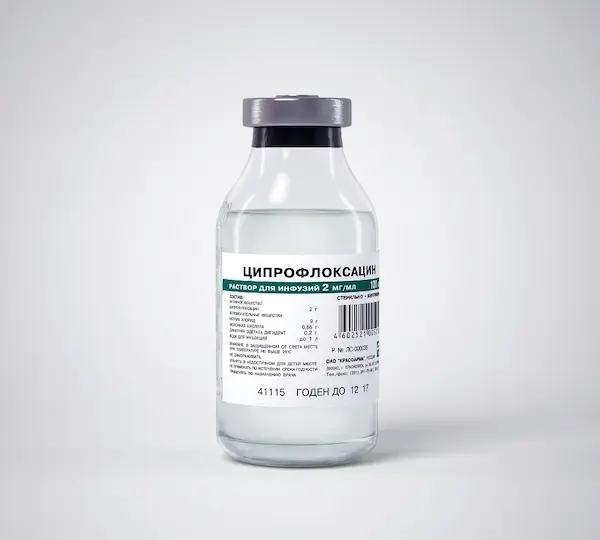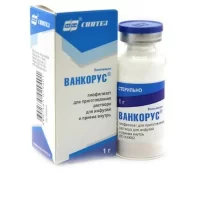Description
Ciprofloxacin infusions Pharmacodynamics
Ciprofloxacin is a synthetic broad-spectrum antibacterial agent of fluoroquinolones group.
Mechanism of action. Ciprofloxacin has activity in vitro against a wide range of Gram-negative and Gram-positive microorganisms. Bactericidal action of ciprofloxacin is achieved by inhibiting bacterial topoisomerase II type (topoisomerase II (DNA-gyrase) and topoisomerase IV), which are necessary for bacterial DNA replication, transcription, repair and recombination.
Mechanisms of resistance. In vitro resistance to ciprofloxacin is often due to point mutations in bacterial topoisomerases and DNA lyase and develops slowly through multistep mutations.
Single mutations can lead to decreased sensitivity rather than to the development of clinical resistance, but multiple mutations mainly lead to the development of clinically significant resistance to ciprofloxacin and to cross-resistance to quinolone drugs.
Resistance to ciprofloxacin, as well as to many other antibiotics, can form as a result of decreased permeability of the bacterial cell wall (as often occurs in the case of Pseudomonas aeruginosa) and/or activation of excretion from the germ cell (efflux). The development of resistance due to the Qnr gene localized on plasmids has been reported. Resistance mechanisms that lead to inactivation of penicillins, cephalosporins, aminoglycosides, macrolides and tetracyclines probably do not impair the antibacterial activity of ciprofloxacin. Microorganisms resistant to these drugs are usually sensitive to ciprofloxacin.
The minimum bactericidal concentration (MBC) usually does not exceed the minimum inhibitory concentration (MIC) by more than 2-fold.
Indications
Uncomplicated and complicated infections caused by ciprofloxacin-sensitive microorganisms.
For adult patients:
– respiratory tract infections.
Ciprofloxacin is recommended for pneumonias caused by Klebsiella spp., Enterobacter spp., Proteus spp., Escherichia coli, Pseudomonas aeruginosa, Haemophilus spp., Moraxella catarrhalis, Legionella spp. and staphylococci,
– middle ear infections (otitis media), sinus infections (sinusitis), especially if these infections are caused by staphylococci and Gram-negative microorganisms, including Pseudomonas aeruginosa,
– eye infections,
– kidney infections and/or complicated urinary tract infections,
– genital infections, including adnexitis, gonorrhea, prostatitis,
– abdominal infections (bacterial infections of the gastrointestinal tract, biliary tract, peritonitis),
– Skin and soft tissue infections,
– bone and joint infections.
– sepsis,
– infections or prophylaxis of infections in immunocompromised patients (patients taking immunosuppressants or patients with neutropenia),
– selective intestinal decontamination in immunocompromised patients,
– prevention and treatment of inhalational anthrax (infection with Bacillus anthracis).
For the treatment of the following infectious and inflammatory diseases, Ciprofloxacin may be used only as an alternative to other antimicrobial agents:
– acute sinusitis,
– uncomplicated urinary tract infections.
Existing official guidelines on the correct use of antibacterial agents should be taken into account.
Children
– Treatment of complications caused by Pseudomonas aeruginosa in children with pulmonary cystic fibrosis from 5 to 17 years of age,
– Prevention and treatment of inhalational anthrax (infection with Bacillus anthracis).
The use of ciprofloxacin in children should be initiated only after a benefit/risk assessment due to possible adverse effects on joints and periarticular tissues.
Contraindications
Hypersensitivity to ciprofloxacin or other drugs from the group of fluoroquinolones, as well as to excipients included in the dosage form (see section “Composition”).
Concomitant use of ciprofloxacin and tizanidine due to clinically significant side effects (hypotension, somnolence) associated with increased plasma concentration of tizanidine (see section “Interaction with other medicinal products”).
Caution:
Severe cerebral vascular atherosclerosis, impaired cerebral circulation; diseases of the central nervous system (CNS): Epilepsy, decreased seizure threshold (or history of seizures), organic brain lesions or stroke; Increased risk of QT interval prolongation or development of “pyritis” type arrhythmias (e.g., congenital prolongation of the QT interval syndrome, heart disease (heart failure, myocardial infarction, bradycardia), electrolyte imbalance (e.g., hypokalemia, hypomagnesemia)), concurrent use of medications that prolong the QT interval (including antiarrhythmic drugs). including class IA and III antiarrhythmic drugs, tricyclic antidepressants, macrolides, neuroleptics); elderly age; tendon affection with previous treatment with quinolones; expressed renal and/or hepatic insufficiency; concurrent use with CYP4501A2 isoenzyme inhibitors, (including theophylline, methotrexate, methotrexate and caffeine). including theophylline, methylxanthine, caffeine, duloxetine, clozapine, ropinirole, olanzapine); mental disorders; myasthenia gravis; glucose-6-phosphate dehydrogenase deficiency.
Use in pregnancy and during breast-feeding:
The safety of use in pregnant women has not been established. However, based on the results of animal studies the possibility of adverse effects on fetal articular cartilage cannot be excluded, in this regard ciprofloxacin should not be administered to pregnant women. At the same time, no teratogenic effect was found in animal studies. Ciprofloxacin penetrates into breast milk. Because of the potential risk of articular cartilage damage in infants, Ciprofloxacin infusions should not be administered to breastfeeding women.
Hypersensitivity to ciprofloxacin or other drugs from the group of fluoroquinolones, as well as to excipients included in the dosage form (see section “Composition”).
Concomitant use of ciprofloxacin and tizanidine due to clinically significant side effects (hypotension, somnolence) associated with increased plasma concentration of tizanidine (see section “Interaction with other medicinal products”).
Caution:
Severe cerebral vascular atherosclerosis, impaired cerebral circulation; diseases of the central nervous system (CNS): Epilepsy, decreased seizure threshold (or history of seizures), organic brain lesions or stroke; Increased risk of QT interval prolongation or development of “pyritis” type arrhythmias (e.g., congenital prolongation of the QT interval syndrome, heart disease (heart failure, myocardial infarction, bradycardia), electrolyte imbalance (e.g., hypokalemia, hypomagnesemia)), concurrent use of medications that prolong the QT interval (including antiarrhythmic drugs). including class IA and III antiarrhythmic drugs, tricyclic antidepressants, macrolides, neuroleptics); elderly age; tendon affection with previous treatment with quinolones; expressed renal and/or hepatic insufficiency; concurrent use with CYP4501A2 isoenzyme inhibitors, (including theophylline, methotrexate, methotrexate and caffeine). including theophylline, methylxanthine, caffeine, duloxetine, clozapine, ropinirole, olanzapine); mental disorders; myasthenia gravis; glucose-6-phosphate dehydrogenase deficiency.
Use in pregnancy and during breast-feeding:
The safety of use in pregnant women has not been established. However, based on the results of animal studies the possibility of adverse effects on fetal articular cartilage cannot be excluded, in this regard ciprofloxacin should not be administered to pregnant women. At the same time, no teratogenic effect was found in animal studies. Ciprofloxacin penetrates into breast milk. Because of the potential risk of articular cartilage damage in infants, Ciprofloxacin infusions should not be administered to breastfeeding women.
Dosage and administration
- Adults. In the absence of other prescriptions, the following dosing regimen is recommended:
- Table 1. Recommended doses of Ciprofloxacin infusions in adults.
- Indication Single dose for adults, including number of times per day (ciprofloxacin, mg, i.v.)
- Respiratory tract infections (depending on the severity of the infection and the patient’s condition) 400 mg × 2 times a day to 400 mg × 3 times a day
- Infections of the genitourinary system:
- – acute, uncomplicated
- – complicated
- – Adnexitis, prostatitis, orchitis, epididymitis 200 mg x 2 times a day to 400 mg x 2 times a day.
- 400 mg × 2 times a day to 400 mg × 2 times a day
- 400 mg × 2 times a day to 400 mg × 3 times a day
- Diarrhea 400 mg × 2 times a day
- Other infections (see section “Indications for use”) 400 mg × 2 times daily
- Particularly severe, life-threatening infections, especially with Pseudomonas spp. Staphylococcus spp. or Streptococcus spp.
- – Pneumonia caused by Streptococcus spp.
- – Recurrent cystic fibrosis infections
- – bone and joint infections
- – septicemia
- – peritonitis 400 mg × 3 times a day
- Pulmonary anthrax (treatment and prophylaxis) 400 mg × 2 times daily (adults)
- Children and adolescents
- Table 2. Recommended doses of Ciprofloxacin infusions in children and adolescents.
- Indication Single dose for children and adolescents based on number of times per day (ciprofloxacin, mg, IV administration)
- Cystic fibrosis infections 10 mg/kg body weight × 3 times daily (maximum dose 400 mg)
- Pulmonary anthrax (post-exposure) 10 mg/kg body weight × 2 times daily (maximum single dose 400 mg)
- Use in selected patient groups
- Dosing regimen in elderly patients (older than 65 years)
- In elderly patients, lower doses of ciprofloxacin should be prescribed depending on the severity of the disease and creatinine clearance (CK) values (see also information on patients with liver and/or renal dysfunction).
- Dosing regimen for inhalational anthrax (treatment and prophylaxis)
- See information in Tables 1 and 2.
- Treatment should be started as soon as infection is suspected or confirmed. Total duration of treatment with ciprofloxacin for inhalational anthrax is 60 days.
- Dosing regimen for renal or hepatic impairment in adults
- Table 3: Recommended dosages for patients with renal impairment.
- Creatinine clearance (ml/min/1.73 m2) Plasma creatinine (mg/100 ml) Total daily dose of Ciprofloxacin
- 30-60 1.4-1.9 Maximum 800 mg
- <30 ≥2.0 Maximum 400 mg
- Dosing regimen in patients with renal insufficiency on hemodialysis
- – In case of CKD 30-60 ml/min/1.73 m2 (moderate renal insufficiency) or its concentration in plasma 1.4-1.9 mg/100 ml the maximum daily dose of Ciprofloxacin should be 800 mg.
- – In case of CKD <30 ml/min/1.73 m2 (severe renal failure) or its concentration in plasma ≥2 mg/100 ml the maximum daily dose of Ciprofloxacin should be 400 mg during the days of hemodialysis after the procedure.
- Dosing regimen in patients with renal failure on permanent ambulatory peritoneal dialysis
- The drug Ciprofloxacin is added to dialysate (intraperitoneally): 50 mg of ciprofloxacin per liter of dialysate is administered 4 times daily every 6 h.
- Dosing regimen in patients with hepatic impairment
- No dosage adjustment is required.
- Dosing regimen in patients with impaired renal and hepatic function
- – In case of CKD 30-60 ml/min/1.73 m2 (moderate renal insufficiency) or if its concentration in plasma is 1.4-1.9 mg/100 ml the maximum daily dose of Ciprofloxacin should be 800 mg.
- – In case of CKD <30 ml/min/1.73 m2 (severe renal insufficiency) or its concentration in plasma ≥2 mg/100 ml the maximum daily dose of Ciprofloxacin should be 400 mg.
- Dosing regimen in children with renal and/or hepatic dysfunction
- Regimen of dosage in children with kidney and/or liver dysfunction has not been studied.
- Directions for use. Ciprofloxacin is administered as an IV infusion of at least 60 minutes. Ciprofloxacin infusions solution should be administered slowly in a large vein to prevent complications at the site of infusion. The solution can be administered alone or together with other compatible infusion solutions.





